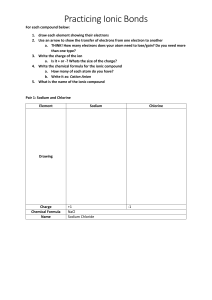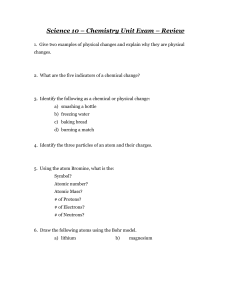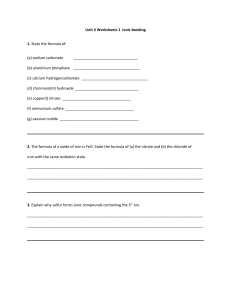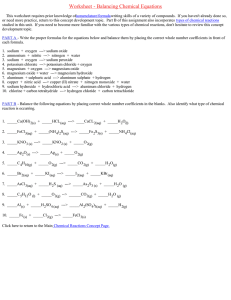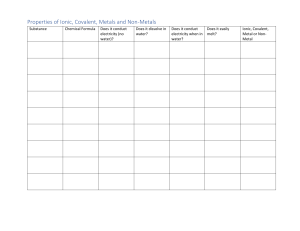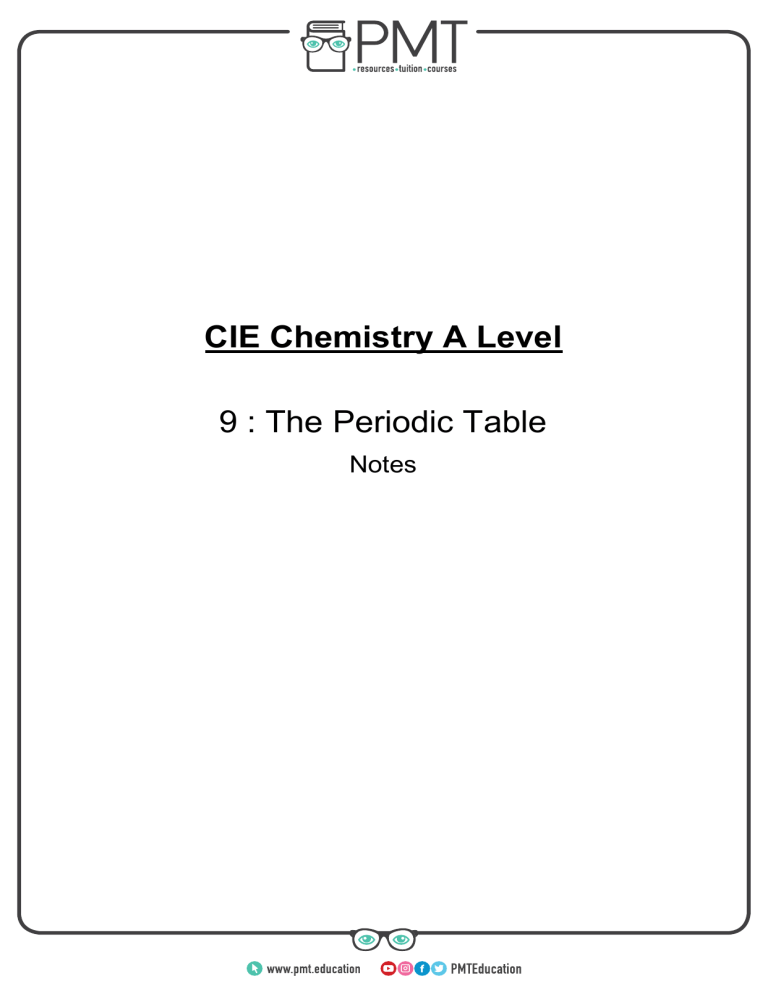
CIE Chemistry A Level 9 : The Periodic Table Notes www.pmt.education Periodicity of physical properties of the elements in Period 3 Atomic radius When comparing the atomic radius of period 3 atoms, the metallic radii is used for Na, Mg and Al an the covalent radii is used for Si, P, S and Cl. Across period three, atomic radius decreases from sodium to chlorine. The radius of argon can’t be compared as it does not form compounds. Across the period, atomic number increases so the nucleus has a higher positive charge. This draws electrons slightly closer to the nucleus meaning the atomic radius decreases. Ionic radius Across period 3, the ionic radius decreases from sodium to aluminium (positive ions) then increases from silicon to chlorine (negative ions). The positive ions have a decreasing ionic radius because, although the ions have the same electron configuration, the number of protons in the nucleus increases so nuclear attraction increases. The negative ions have an increasing ionic radius because the ions have gained electrons meaning there are now more electrons than protons. As a result, the nuclear attraction to the electrons is weaker so they are not pulled in as strongly. Melting point The melting points of elements in period 3 depend on structure and bonding: ● Sodium, magnesium and aluminium are giant metallic structures with metallic bonding. Their melting points increase across the period as the metal-metal bond strength increases. The bond strength increases because the charge of the metal ion increases and the atomic radius decreases. ● Silicon is a macromolecule with strong covalent bonds linking all its atoms together. This means it has the highest melting point of all the elements in period 3. ● Phosphorus (P4), sulfur (S8) and chlorine (Cl2) are all simple covalent molecules. Their melting points are dependent on the strength of their van der Waals/ intermolecular forces. The more atoms in a molecule mean stronger van der Waals forces so sulfur has the greatest melting point of these three molecules. Chlorine will have the lowest melting point since it is only made up of two atoms. ● Argon will have the lowest melting point of period 3 because it exists as single atoms so there are very weak van der Waals intermolecular forces which are easy to overcome. Electrical conductivity Conductivity of a compound relies on the presence of charged particles (such as ions or electrons) which are free to move. Metallic compounds can conduct electricity due to the sea of delocalised electrons. Conductivity increases from sodium to aluminium because the number of delocalised electrons increases so more electrons are free to carry charge. The molecules silicon to chlorine are covalent compounds with no charged particles so they are non-conductors. Similarly argon is monatomic so is unable to conduct electricity. www.pmt.education First ionisation energy The first ionisation energy is the energy required to remove one mole of electrons from one mole of gaseous atoms to form one mole of gaseous ions. First ionisation energy generally increases across period 3. This is because the number of protons increases across the period while electron shielding remains the same. As a result, across the period, the electrons are attracted more strongly to the nucleus so they are harder to remove, leading to a higher first ionisation energy. Exceptions to the trend: ● The first ionisation energy of aluminium is lower than that of magnesium. This is because the electron is being removed from a 3p orbital rather than a 3s orbital. This means there is more electron shielding from the 3s orbital so the electron can be removed more easily. ● The first ionisation energy of sulfur is lower than that of phosphorus. Sulfur is the first element to have an electron pair in a 3p orbital so an electron is being removed from a pair. The electrons in the pair repel each other slightly making it easier to remove an electron. Properties of ceramics The term ceramics is usually applied to any class of non-metal inorganic product which has been subjected to high temperatures. Ceramics can either be giant covalent structures or giant ionic structures. Examples of ceramics include magnesium oxide, aluminium oxide and silicon dioxide. Strength: The strong covalent or ionic bonds that hold the atoms / ions together in a giant ceramic structure make it strong and hard. Despite this, they are also brittle. Whilst metals bend before they fracture, ceramics fracture straight away as the covalent bonds break or the ionic lattice is distorted. Melting point: Ceramics with a giant covalent structures (like silicon dioxide) have many covalent bonds which require a lot of energy to break. This means they have high melting points. Ceramics with giant ionic structures (like aluminium oxide and magnesium oxide) have strong electrostatic attraction between the oppositely charged ions which requires a lot of energy to break. This means they also have high melting points. Electrical insulating properties: Ceramics are generally good electrical insulators. This is because giant covalent compounds have no charged particles so are unable to carry charge. In ionic compounds, the ions are fixed in an ionic lattice when solid so they are unable to carry charge when solid. This means they are good electrical insulators in the solid state. www.pmt.education Periodicity of chemical properties of the elements in Period 3 Reactions with oxygen ● ● ● ● ● ● ● ● Sodium burns in oxygen with an orange flame to produce a white solid. 4Na + O2 → 2Na2O Magnesium burns in oxygen with a bright white flame to produce a white solid. 2Mg + O2 → 2MgO Aluminium burns in oxygen if the aluminium oxide layer on the outside of the metal is removed. This can be done by powdering the aluminium. Sparks can be seen when the powder is burned and a white solid is produced. 4Al + 3O2 → 2Al2O3 Silicon will only burn in oxygen if it is heated strongly enough. Si + O2 → SiO2 White phosphorus reacts spontaneously in the air to produce a white solid. P4 + 5O2 → P4O10 Sulfur burns with a blue flame in oxygen when heated gently. It produces a colourless gas of sulfur dioxide which reacts further with oxygen to form sulfur trioxide. S + O2 → SO2 2SO2 + O2 → 2SO3 Chlorine does not react with oxygen (directly). Argon does not react with oxygen. Reactions with chlorine ● ● ● ● ● Sodium burns in chlorine with a bright orange flame to form sodium chloride (white solid). 2Na + Cl2 → 2NaCl Magnesium burns in chlorine with a bright white flame to form magnesium chloride (white solid). Mg + Cl2 → MgCl2 Aluminium burns in a stream of chlorine to produce pale yellow aluminium chloride. 2Al + 3Cl2 → 2AlCl3 At high temperatures, aluminium chloride (AlCl3) is converted into its molecular form Al2Cl6. If chlorine is passed over silicon powder, a colourless liquid forms (silicon tetrachloride). Si + 2Cl2 → SiCl4 White phosphorus burns spontaneously in chlorine to produce phosphorus(V) chloride (off-white solid). P4 + 10Cl2 → 4PCl5 Reactions with water ● ● Sodium undergoes a very exothermic reaction with cold water, producing hydrogen (seen as bubbles) and a colourless solution of sodium hydroxide. 2Na + 2H2O → 2NaOH + H2 Magnesium reacts slowly with cold water. Bubbles of hydrogen are produced and a thin layer of magnesium hydroxide forms on the magnesium which inhibits further reaction. Mg + H2O → Mg(OH)2 + H2 www.pmt.education Magnesium burns in steam with a bright white flame to produce white magnesium oxide and hydrogen: Mg + H2O → MgO + H2 Variation in oxidation numbers Oxidation states can be worked out using the following rules: ● The oxidation state of an uncombined element is 0. ● The sum of oxidation states in a compound is 0 and the sum of oxidation states in an ion is equal to the overall charge. ● Common oxidation states: ○ +1 for group one atoms ○ +2 for group two atoms ○ -2 for oxygen (except when in a peroxide or F2O) ○ +1 for hydrogen (except in metal hydrides where it is -1) ○ -1 for fluorine ○ -1 for chlorine (except when bonded with fluorine or oxygen) The oxidation states of group 3 oxides are shown in the table below: Compound Oxidation state of non-oxygen element Na2O +1 MgO +2 Al2O3 +3 SiO2 +2 P4O10 +5 SO2 +6 SO3 +4 The oxidation states of group 3 chlorides are shown in the table below: Compound Oxidation state of non-chlorine element NaCl +1 MgCl2 +2 AlCl3 +3 SiCl4 +4 PCl4 +5 www.pmt.education In each of the cases above, the oxidation state has the same value as the number of valence shell electrons (the number of electrons in the outer energy level of the atom). Period 3 oxides and water ● ● ● ● ● ● ● Sodium oxide is a strongly basic oxide which reacts exothermically with water to form a solution of sodium hydroxide (around pH 14). Na2O + H2O → 2NaOH Magnesium oxide undergoes a slight reaction with water, forming some magnesium hydroxide ions. As these are only partially soluble, the pH of the resulting solution is about 9 since not many hydroxide ions are released into the solution. MgO + H2O → Mg(OH)2 Aluminium oxide does not react with water. Silicon dioxide does not react with water because it is difficult to break up the macromolecule. Phosphorus(V) oxide reacts violently with water to form phosphoric acid. P4O10 + 6H2O → 4H3PO4 Sulfur dioxide reacts with water to form an acidic solution of sulfurous acid. SO2 + H2O → H2SO3 Sulfur trioxide reacts violently with water to produce sulfuric acid. SO3 + H2O → H2SO4 Acid / base behaviour of period 3 oxides and hydroxides Oxides: ● ● ● ● ● ● ● Sodium oxide is a strong base which reacts with acid to form a salt and water. Na2O + 2HCl → 2NaCl + H2O Magnesium oxide reacts with warm dilute hydrochloric acid to form a salt and water. MgO + HCl → MgCl2 + H2O Aluminium oxide is amphoteric so reacts with acids and bases. It reacts with warm dilute hydrochloric in the same way as magnesium and sodium: Al2O3 + 6HCl → 2AlCl3 + 3H2O Aluminium oxide also reacts with bases: Al2O3 + 2NaOH + 3H2O → 2NaAl(OH)4 Silicon dioxide reacts with hot concentrated sodium hydroxide solution. A colourless solution is formed. SiO2 + NaOH → Na2SiO3 + H2O Phosphorus(V) oxide can form a range of salts when reacted with a base. Here is one example: P4O10 + 12NaOH →4Na3PO4 + 6H2O Sulfur dioxide will react with a base when bubbled through it: SO2 + NaOH → Na2SO3 + H2O Sulfur trioxide reacts with a base to form sulfuric acid and water. SO3 + 2NaOH → Na2SO4 + H2O www.pmt.education Hydroxides: ● ● ● Sodium and magnesium hydroxides are both simple basic hydroxides. NaOH + HCl → NaCl + H2O Mg(OH)2 + 2HCl → MgCl2 + 2H2O Aluminium hydroxide is amphoteric so will react with acids and bases: Al(OH)3 + 3HCl → AlCl3 + 3H2O Al(OH)3 + NaOH → NaAl(OH)4 The other period three hydroxides each act as acids since the OH group is covalently bonded to the element. Period 3 chlorides and water ● ● ● ● ● Sodium chloride and magnesium chloride are ionic compounds so they dissolve in water to form their ions. Aluminium chloride reacts violently with water. Lots of misty fumes of hydrogen chloride are produced: AlCl3 + 6H2O → [Al(H2O)6]3+ + 3Cl An equilibrium is set up with the product so H+ ions, and hence HCl, are formed: 3+ 2+ + [Al(H2O)6] ⇌ [Al(H2O)5(OH)] + H Silicon tetrachloride reacts with water in the air to produce hydrogen chloride. SiCl4 + 2H2O → SiO2 + 4HCl Phosphorus(V) chloride also reacts violently with water to produce hydrogen chloride. PCl5 + H2O → POCl3 + 2HCl Disulfur dichloride reacts slowly with water to produce a range of products. There are lots of examples of equations that could take place so it is unlikely this will be asked in an exam. Potential products include HCl, S and H2S. Chemical bonding in chlorides and oxides In chlorides and oxides, the chemical bonding is ionic from sodium to aluminium and covalent from silicon to sulfur. This can be deduced from observing the physical and chemical properties of the chloride or oxide being analysed. Sodium and magnesium form ionic bonds with oxygen and chlorine. Aluminium forms covalent bonds with oxygen and either covalent or ionic bonds with chlorine. Other period 3 elements form simple molecular compounds (covalent). This is because the difference in electronegativity between chlorine/ oxygen and the period 3 element decreases across the period. There is sufficient difference in the electronegativity of chlorine/ oxygen and sodium or magnesium to form ions. After aluminium, the difference in electronegativity is too small for ions to form. Bonding and properties of chlorides and oxides The type of bonding can be deduced using the physical properties of group 3 compounds. For example, a high melting point means that it is a giant molecular structure, either ionic like NaCl and MgO or covalent like SiO2. www.pmt.education Chemical properties can also be used to identify the type of bonding: - Chlorides that dissolve in water to form a solution with a pH close to 7 are ionic whereas chloride that react with water to form an acidic solution and hydrogen chloride gas are covalent. - If a period 3 oxide forms an acidic solution when it dissolves in water, it is covalent. If it is ionic, it may react with water to form an alkaline solution or it may not react with water. - Generally, ionic oxides are basic and can react with acids. Covalent oxides tend to be acidic and can react with bases.Amphoteric oxides such as aluminium oxide are usually ionic with some covalent character. - If a molten oxide or chloride can undergo electrolysis, it must be ionic. Chemical periodicity of other elements The chemical properties of an element can be predicted by using knowledge of chemical periodicity. Similarly, an unknown element can be identified from information given about its chemical and physical properties. www.pmt.education
